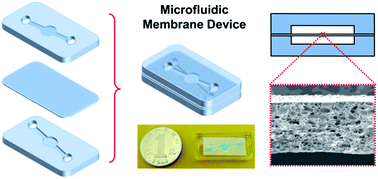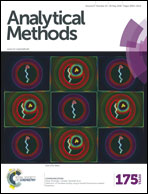Online monitoring of ethanol concentration using a responsive microfluidic membrane device†
Abstract
A novel method for online monitoring of ethanol concentration has been proposed by successfully developing an ethanol-responsive microfluidic membrane device. The microfluidic membrane device is fabricated by bonding two patterned polydimethylsiloxane (PDMS) modules with a sandwiched ethanol-responsive membrane via a “stamp-like” method. The PDMS modules are prepared by soft lithography and the ethanol-responsive membrane is prepared by blending poly(N-isopropylacrylamide) nanogels into the membrane-forming solution via a vapor-induced phase separation process. The developed microfluidic membrane device shows excellent ethanol-responsive characteristics, rapid responsive rate, and good repeatability and stability. With the microfluidic membrane device, a significant difference in fluxes of ethanol solutions with different concentrations can be directly observed. At certain temperatures, the microfluidic membrane device shows critical responsive ethanol concentrations around 10 vol%, e.g., 13.0 vol% at 25 °C and 7.8 vol% at 30 °C. For real fermentation broths, the microfluidic membrane device still shows excellent response and detection performances, which demonstrates that the microfluidic membrane device is highly promising to be applied to monitor the ethanol concentration in fermentation processes.

- This article is part of the themed collection: Microfluidics Research 2015-2016

 Please wait while we load your content...
Please wait while we load your content...